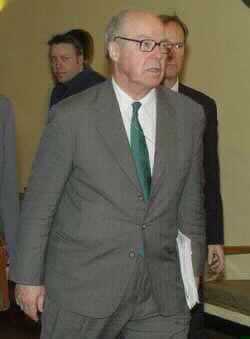Chief U.N. inspector Hans Blix on Monday spelled out exactly what Iraq must do to prove it has disarmed and avoid U.S.-led military action, even as war looms. In a report to the Security Council, Blix said if Saddam Hussein cooperates, the dozen key remaining disarmament issues could be resolved in months. France, Russia and Germany have seized on Blix's presentation of the disarmament tasks to call for a council meeting Wednesday to set a "realistic" timeline to complete the tasks.
But with efforts to disarm Iraq peacefully apparently at an end, the exercise appeared futile to many diplomats. In a televised address Monday evening, President Bush gave Saddam a 48-hour deadline to flee Iraq or face a U.S.-led invasion.
Blix whittled down a 173-page dossier on Iraq's weapons of mass destruction, which he gave to the council earlier this month, to pick a dozen key remaining disarmament tasks, each with questions Iraq must answer.
The chief inspector was required to produce the list before the end of March but speeded up its presentation at the request of France, Germany and other council members.
The list, obtained by The Associated Press, includes many of the key issues in the dossier - anthrax, VX nerve agent, mustard gas, missiles, chemical and biological munitions and warheads, drones and Scud missiles.
Blix said inspectors would pursue Iraq's fulfillment of the disarmament requirements "simultaneously and with the same priority" once they are approved by the council.
He listed the following tasks and actions that Iraq can take to resolve them:
_ Present any Scud missiles and associated biological and chemical warheads or explain what happened to them.
_ Provide information on SA-2 missile technology and related projects, and present any remaining Fahad missiles.
_ Present all materials related to missiles capable of going beyond the U.N. limit of 93 miles, and their components.
_ Present any remaining chemical and biological munitions, including aerial bombs, rockets or missile warheads, artillery shells, cluster munitions and production equipment, and provide "credible evidence" about these programs.
_ Provide details of any drones or equipment for them, and present any spray tanks or other devices that could be used for chemical or biological warfare.
_ Present any remaining VX nerve agent and provide "credible evidence" to support any quantities of VX that were produced, consumed, destroyed or spoiled.
_ Present any remaining mustard gas and similar credible evidence.
_ Present any remaining Sarin nerve agent and similar credible evidence.
_ Present any remaining stocks of anthrax or provide evidence for its destruction and provide information on any work to dry anthrax.
_ Present any remaining stocks of botulinum toxin, a biological warfare agent, and complete production records since 1989 as well as evidence on the numbers of weapons filled with the toxin.
_ Present any stocks of undeclared biological warfare agents, and all information on research or production of smallpox after 1972.
_ Present any banned chemical or biological agents, precursors, missiles, mobile and underground facilities for chemical and biological weapons that have been acquired since 1998 when U.N. inspectors left Iraq.
PHOTO CAPTION
Chief United Nations weapons inspector Hans Blix heads into a meeting of the U.N. Security Council Monday, March 17, 2003. (AP Photo/Richard Drew)
- Author:
& News Agencies - Section:
WORLD HEADLINES


 Home
Home Discover Islam
Discover Islam Quran Recitations
Quran Recitations Lectures
Lectures
 Fatwa
Fatwa Articles
Articles Fiqh
Fiqh E-Books
E-Books Boys & Girls
Boys & Girls  Articles
Articles










